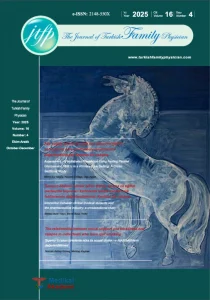The relationship between adolescents’ preferences of psychiatric interviews’ duration and sociodemographic and clinical features and its effect on psychiatric treatment
Aim: Psychiatrist’s knowledge of adolescent’s information about the psychiatric interview and the process at the duration of adolescent’s admission will improve the collaboration between adolescent and the psychiatrist. In this study, we aimed to investigate the relationship between the clinical features and the adolescents’ duration prefe-rences of psychiatric interviews.
Method: Clinical characteristics of the patients was determined retrospectively from patient follow-up file. Two hundred three adolescents between 12-21 years old were recruited in the study. They were assessed in a psychiatry outpatient service. Preferences were asked to the patients who agreed to participate before starting the interview. Short Psychiatric Interview group and Long Psychiatric Interview group were identified.
Results: As a result, more than half of those who prefered short psychiatric interview were girls (61% girls, 39% boys). Type of the treatment given by psychiatrists was affected by patients’ interview pre-ferences. Psychiatrists preferred more drug treatment for those who preferred short interview (p<0,05). Also they gave more counseling services for those who preferred long interview (p>0,05). The data obtained Show that the ideas of adolescents on psychiatric interview duration can change the approach to treatment of psychiatrists.
Conclusions: Knowledge about the psychiatric duration of adolescent’s admission and explaining the psychiatric evaluation process in accordance with the adolescent stage of development to the patient will improve the collaboration of patient-physician relationship and the coherence of the treatment process. It is important to know adolescent thoughts from the first interview on psychiatric examination.
Key words: Adolescent, patient physician relationship, psychiatric interview, duration
References
- Bahadır G. Genel tıpta hekim-hasta iletişimi. “Psikiyatri” içinde. (ed) Kulaksızoğlu I, Tükel R, Üçok A, Yargıç İ, Yazıcı O. İstanbul, İstanbul Üniversitesi Basım ve Yayınevi. 2009:1-17.
- Özer Ü, Çeri V, Özgen G, Turan B. The preferred clothing style in psychiatrists and its effect on the patient-physician relationship. Anadolu Psikiyatri Derg 2016;17(1):51-5.
- Cepeda C. General Principles of Interviewing. In “Clinical manual for the psychiatric interview of children and adolescents”. 1 st ed. Arlington, American Psychiatric Pub. 2009:17-60.
- Tasman A, Kay J, Ursano R. Physician–Patient Relationship. In “The Psychiatric Interview: Evaluation and Diagnosis.”. 3rd ed. West Sussex, John Wiley & Sons. 2013: 32-33.
- Bereiter J. Psychiatric Evaluation of children and adolescents: It takes time. Psychiatr Times 2007;24(6):69.
- Pridmore S. The Psychiatric History. In “The Psychiatric Interview: A Guide to History Taking and the Mental State Examination”. 1 st ed. Australia, Harwood Academic Publishers. 2000: 1.
- Parman T. Ergenlerde psikiyatrik görüşmenin çerçevesi. Çocuk ve Gençlik Ruh Sağlığı Dergisi 1995;2(3):160-3.
- Akıcı A, Mollahaliloğlu S, Özgülcü Ş, Dönertaş B, Alkan A. Birinci basamak sağlık merkezlerine ve devlet hastanelerine başvuran hastaların aldıkları sağlık hizmetinin akılcı ilaç kullanımı açısından değerlendirilmesi. Turkish Family Physician 2015;6(1):30-9.
- Yıldız N, Sevi OM, Soykal İ, Odabaşıoğlu G, Genç Y. Psikoloji öğrencileri ve mezunlarının psikiyatrik rahatsızlıklar ve bağımlılığa ilişkin bakış açılarının değerlendirilmesi. Bağımlılık Dergisi 2014;15(4):173-9.
- Markin RD, McCarthy KS, Barber JP. Transference, countertransference, emotional expression, and session quality over the course of supportive expressive therapy: The raters’ perspective. Psychother Res 2013;23(2):152-168.



